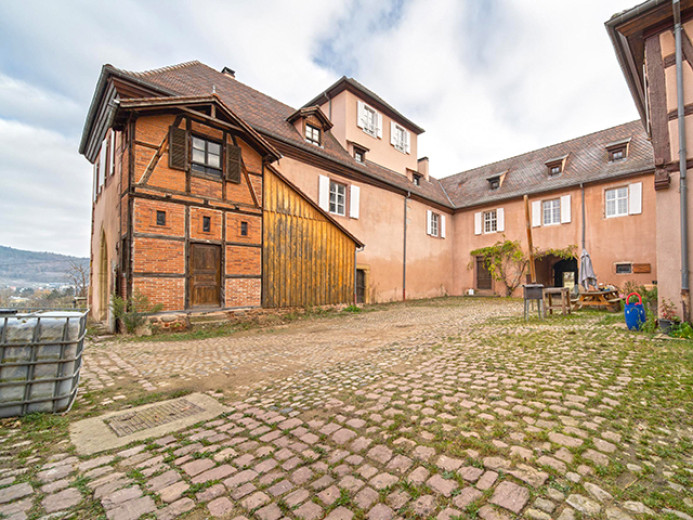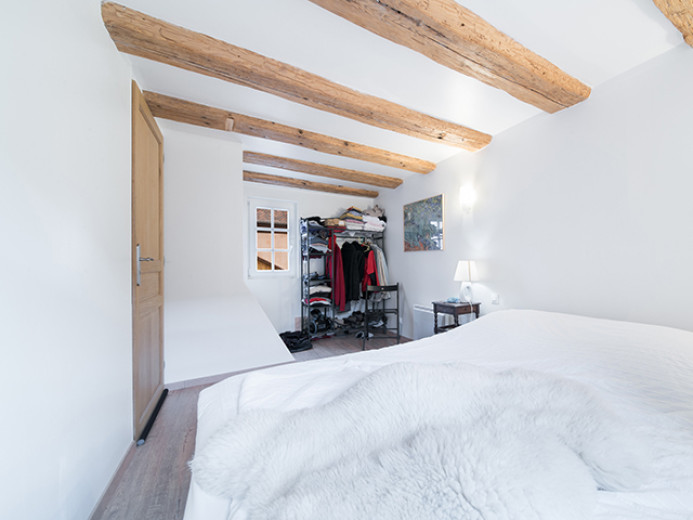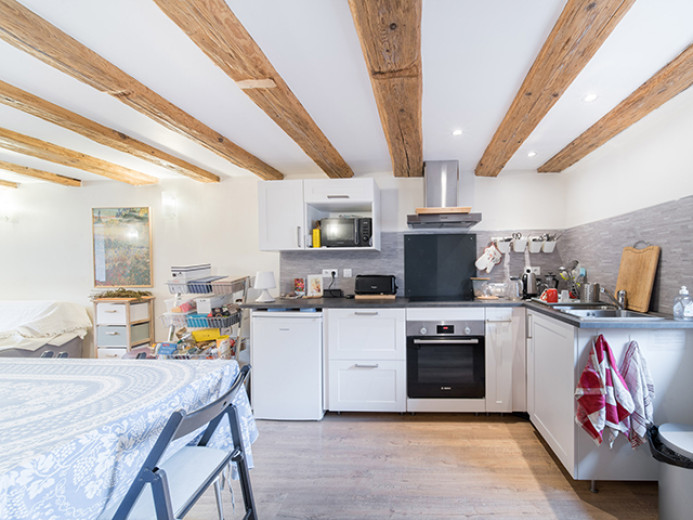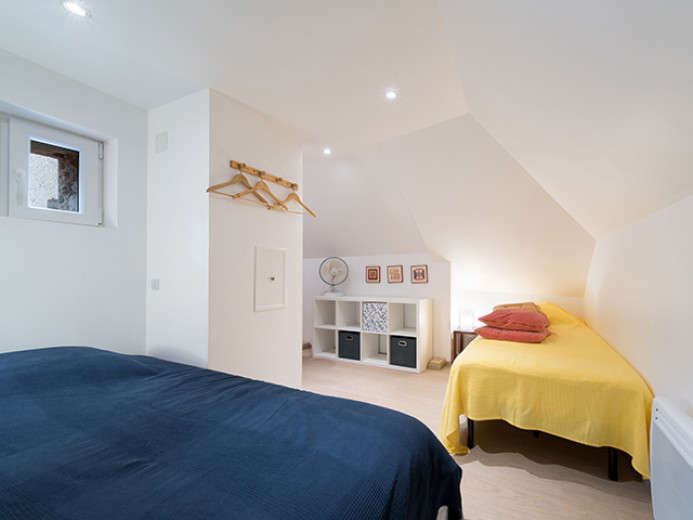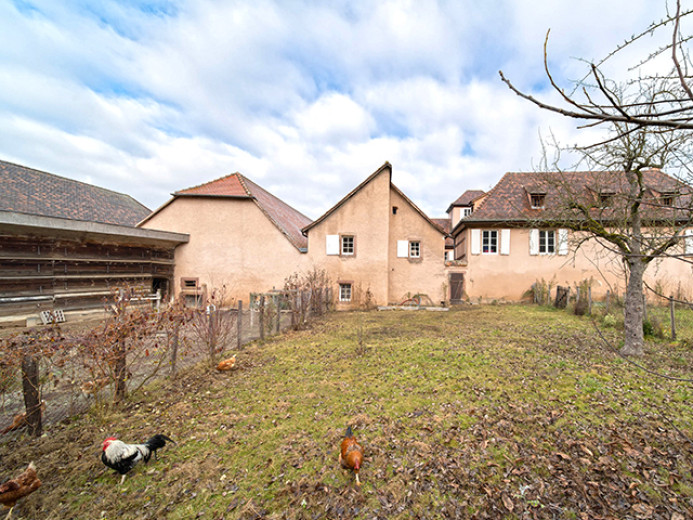WINTZENHEIM - NICE MANSION - 21.0 ROOMS
€1,950,000
Details
Rooms
21 rooms
Living area
1310 m2
Land surface
176900 m2
Number of floors
3 floors
Floor
Ground floor
Environment
Village
Parking
Indoor, Outdoor, Motorcycle
Year of construction
1148
Available on
On request
Price
Price
€1,950,000
Condition
Interior condition
Good condition
Exterior condition
Good condition
Parking space
Indoor parking space
Outdoor parking space
Motorcycle parking space
Description
A few minutes from Colmar, at the gateway to the Munster valley and at the start of numerous hiking trails linking the region's emblematic medieval castles, stands the Saint-Gilles estate, a unique multi-century building of undeniable charm. The complex consists of buildings and various outbuildings surrounded by 17.69 hectares of meadows and farmland.
Reflecting a past ecclesiastical prosperity, the place appears in the archives as early as 1148 as an emanation of the Saint-Pierre de Colmar priory, itself subject to the Helvetic abbey of Payerne (Canton of Vaud). The arrival of the Reformation coincided with the acquisition of the agricultural estate in 1575 by the town of Colmar, which kept it until 1714, when Louis XIV entrusted the abandoned church to the care of the Grand Chapter of Strasbourg Cathedral.
In 1777, heavy restoration work saw the roof of the chapel reunited with the dwelling, the drilling of new windows in the façade and the renovation of the wall paintings, which were hidden under plaster during the French Revolution.
Sold as national property, the City of Colmar acquired the estate once again in 1793 until it sold it in 1815 to a merchant who organised the desecration of the chapel, thus putting an end to the Wintzenheim pilgrimage which had reappeared a decade earlier. The chapel is divided into two levels with a dwelling on the first floor, served by a beautiful wooden staircase. The skylight also dates from this period.
In 2002, the building was partially listed in the supplementary inventory of historical monuments. The listed elements are: the facades and roofs, the chestnut balustrade staircase (East wing) and the former St-Gilles chapel with its remains of polychrome wall paintings depicting scenes from the life of St-Gilles (North wing).
Numerous preservation and development works have recently been carried out: complete renovation of the roofs (insulation - roofing - frames), interior fittings, electrical and sanitary installations, partial replacement of the exterior joinery, additional water supply from a spring located upstream in the mountain (several catchment points + tank of approximately 25m3), kitchen meeting the standards of collective catering used as a processing room, etc.
The site has now been returned to rural use and is particularly well suited to hosting a variety of agricultural, social and cultural activities.
A quelques minutes de Colmar, aux portes de la vallée de Munster et au départ de nombreux sentiers de randonnée reliant les emblématiques châteaux médiévaux de la région, se dresse le domaine de Saint-Gilles, édifice multiséculaire unique en son genre et au charme indéniable. L’ensemble se compose de bâtiments et de diverses dépendances ceinturés par 17,69 hectares de prés et terres agricoles.
Reflet d’une prospérité ecclésiastique passée, le lieu apparait dans les archives dès 1148 comme une émanation du prieuré Saint-Pierre de Colmar, lui-même soumis à l’abbaye helvétique de Payerne (Canton de Vaud). L'arrivée de la Réforme coïncide avec l'acquisition du domaine agricole en 1575 par la ville de Colmar, qui le conserva jusqu'en 1714, date à laquelle Louis XIV confia l’église abandonnée aux bons soins du Grand Chapitre de la Cathédrale de Strasbourg.
En 1777, de lourds travaux de restauration virent la toiture de la chapelle réunie au logis, le percement de nouvelles fenêtres en façade et la rénovation des peintures murales qui seront cachées sous du plâtre lors de la Révolution Française.
Vendu comme bien national, la Ville de Colmar se porte une nouvelle fois acquéreur du domaine en 1793 jusqu'à ce qu'elle le revende en 1815 à un négociant qui organisa la désacralisation de la chapelle mettant ainsi fin au pèlerinage de Wintzenheim réapparu une décennie plus tôt. La chapelle est partagée en deux niveaux avec un logement à l'étage, desservi par un bel escalier en bois. Le lanterneau date également de cette époque.
En 2002, l'édifice a fait l'objet d'une inscription partielle à l’inventaire supplémentaire des monuments historiques. Les éléments classés sont : les façades et toitures, l’escalier à balustres en châtaignier (Aile Est) et l’ancienne chapelle St-Gilles avec ses vestiges de peintures polychromes murales présentant des scènes de la vie de Saint-Gilles (Aile Nord).
De nombreux travaux de préservation et d’aménagement ont été réalisés récemment : réfection complète des toitures (isolation – couvertures – charpentes), aménagements intérieurs, installations électriques et sanitaires, remplacement partiel des menuiseries extérieures, adduction complémentaire d’eau depuis une source située en amont dans la montagne (plusieurs points de captage + cuve d’environ 25m3), cuisine aux normes de restauration collective à usage de local de transformation, etc.
Renouant avec son passé, le site a aujourd’hui retrouvé un usage rural et se prête particulièrement bien à l’accueil d’activités agricoles, sociales ou culturelles diversifiées.
Nur wenige Minuten von Colmar entfernt, an den Toren des Munstertals und am Ausgangspunkt zahlreicher Wanderwege, die die emblematischen mittelalterlichen Burgen der Region miteinander verbinden, erhebt sich die Domäne Saint-Gilles, ein einzigartiges, jahrhundertealtes Gebäude mit unbestreitbarem Charme. Der Komplex besteht aus Gebäuden und verschiedenen Nebengebäuden, die von 17,69 Hektar Wiesen und Ackerland umgeben sind.
Der Ort spiegelt den früheren kirchlichen Wohlstand wider und erscheint in den Archiven ab 1148 als Ableger des Priorats Saint-Pierre de Colmar, das seinerseits der helvetischen Abtei von Payerne (Kanton Waadt) unterstellt war. Die Einführung der Reformation fiel mit dem Erwerb des landwirtschaftlichen Anwesens im Jahr 1575 durch die Stadt Colmar zusammen, die es bis 1714 behielt, als Ludwig XIV. die verlassene Kirche der Fürsorge des Großkapitels der Kathedrale von Straßburg anvertraute.
Im Jahr 1777 wurde das Dach der Kapelle mit dem Wohnhaus verbunden, neue Fenster in die Fassade eingebaut und die Wandmalereien renoviert, die während der Französischen Revolution unter Gips verborgen wurden.
Nach dem Verkauf als nationales Gut erwarb die Stadt Colmar das Anwesen 1793 erneut, bis sie es 1815 an einen Kaufmann verkaufte, der die Kapelle entweihte und damit der Wallfahrt nach Wintzenheim ein Ende setzte, die ein Jahrzehnt zuvor wieder aufgetaucht war. Die Kapelle ist in zwei Stockwerke unterteilt, wobei sich im Obergeschoss eine Wohnung befindet, die über eine schöne Holztreppe erreichbar ist. Auch die Laterne stammt aus dieser Zeit.
Im Jahr 2002 wurde das Gebäude teilweise in das Zusatzinventar der historischen Denkmäler aufgenommen. Folgende Elemente wurden unter Denkmalschutz gestellt: die Fassaden und Dächer, die Balustertreppe aus Kastanienholz (Ostflügel) und die ehemalige Kapelle St-Gilles mit ihren Überresten polychromer Wandmalereien mit Szenen aus dem Leben des Heiligen Gilles (Nordflügel).
Vor Kurzem wurden zahlreiche Erhaltungs- und Umbauarbeiten durchgeführt: vollständige Erneuerung der Dächer (Isolierung - Bedachungen - Dachstühle), Innenausbau, Elektro- und Sanitärinstallationen, teilweiser Austausch der Außenschreinereien, zusätzliche Wasserversorgung aus einer bergaufwärts gelegenen Quelle (mehrere Entnahmestellen + Tank mit ca. 25 m3 Fassungsvermögen), eine Küche, die den Normen für Gemeinschaftsverpflegung entspricht und als Verarbeitungsraum genutzt werden kann, etc.
Der Standort, der an seine Vergangenheit anknüpft, wird heute wieder ländlich genutzt und eignet sich besonders gut für die Aufnahme vielfältiger landwirtschaftlicher, sozialer oder kultureller Aktivitäten.
A pochi minuti da Colmar, alle porte della valle del Munster e all'inizio di numerosi sentieri escursionistici che collegano gli emblematici castelli medievali della regione, si trova la tenuta di Saint-Gilles, un edificio plurisecolare unico dal fascino innegabile. Il complesso è composto da edifici e vari annessi circondati da 17,69 ettari di prati e terreni agricoli.
Riflettendo una passata prosperità ecclesiastica, il luogo appare negli archivi già nel 1148 come emanazione del priorato di Saint-Pierre de Colmar, a sua volta soggetto all'abbazia elvetica di Payerne (Cantone di Vaud). L'arrivo della Riforma coincise con l'acquisizione della tenuta agricola nel 1575 da parte della città di Colmar, che la mantenne fino al 1714, quando Luigi XIV affidò la chiesa abbandonata alle cure del Gran Capitolo della Cattedrale di Strasburgo.
Nel 1777, pesanti lavori di restauro videro il tetto della cappella riunito all'abitazione, la perforazione di nuove finestre nella facciata e il rinnovamento delle pitture murali, che furono nascoste sotto l'intonaco durante la rivoluzione francese.
Venduta come proprietà nazionale, la città di Colmar acquistò nuovamente la proprietà nel 1793 fino a venderla nel 1815 a un mercante che organizzò la profanazione della cappella, mettendo così fine al pellegrinaggio di Wintzenheim che era ricomparso un decennio prima. La cappella è divisa in due livelli con un'abitazione al primo piano, servita da una bella scala di legno. Anche il lucernario risale a questo periodo.
Nel 2002, l'edificio è stato parzialmente inserito nell'inventario supplementare dei monumenti storici. Gli elementi elencati sono: le facciate e i tetti, la scala con balaustra in castagno (ala est) e l'antica cappella di St-Gilles con i suoi resti di pitture murali policrome che rappresentano scene della vita di St-Gilles (ala nord).
Numerosi lavori di conservazione e di sviluppo sono stati realizzati di recente: rinnovamento completo dei tetti (isolamento - copertura - infissi), arredi interni, installazioni elettriche e sanitarie, sostituzione parziale della falegnameria esterna, approvvigionamento idrico supplementare da una sorgente situata a monte della montagna (diversi punti di captazione + serbatoio di circa 25m3), cucina conforme alle norme della ristorazione collettiva utilizzata come sala di lavorazione, ecc.
Il sito è stato ora restituito all'uso rurale ed è particolarmente adatto ad ospitare una varietà di attività agricole, sociali e culturali.
Equipments
Pets allowed
Attic
Cellar
Garden shed
Nice sight
Supplied with power
Supplied with sewage
Supplied with water
Terrace
Children friendly
Contact the advertiser
Listing ID
6ednnzea
Advertiser ref.
4140330
Contact the advertiser
Share this page
